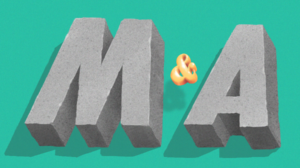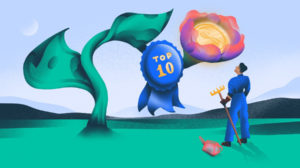Last month, Procter & Gamble called off its planned purchase of Billie, a subscription service for shaving and body-care products for women, after federal antitrust regulators alleged the deal stifled competition.
Subscribe to the Crunchbase Daily
The failed acquisition could be a sign that antitrust regulators are scrutinizing such deals more closely, and that could prompt fewer acquisitions of consumer startups by large companies, according to investors and legal experts — an outcome that could in turn have a chilling effect on VC investment in promising e-commerce and direct-to-consumer brands.
“Billie had the opportunity early-on to sell. The synergy with P&G was there, and the board decided to move forward with them,” said Mike Dodd, general partner at Silverton Partners, which led Billie’s $10 million seed round in 2018. “The business was launched in late 2018, early 2019, and they went from zero to scale and now had the largest consumer packaged goods company interested, and that was impressive — the team did an incredible job.”
Dodd was surprised the Federal Trade Commission challenged the deal, but there was some indication regulators would scrutinize the merger after the FTC filed a lawsuit seeking to block a proposed $1.37 billion transaction between Edgewell Personal Care and Harry’s, a men’s shaving products startup.
In that case, the FTC cited that “the loss of Harry’s as an independent competitor would remove a critical disruptive rival that has driven down prices and spurred innovation in an industry that was previously dominated by two main suppliers, one of whom is the acquirer.” Edgewell decided to terminate the proposed merger in 2020 rather than pursue litigation.
When the FTC moved slowly in deliberating the P&G/Billie deal, Dodd thought that was a bad sign.
“Everybody needs to get liquidity eventually, and it is going to be hard for P&G to acquire companies like Billie because they have market share in each category,” he added. “Any vertical merger is going to be scrutinized. I don’t think it should dampen investor appetite, but it is going to be harder, at least with the current mindset.”
According to the FTC, the Hart–Scott–Rodino Antitrust Improvements Act of 1976 allows for the government to review certain mergers. It was “established to avoid some of the difficulties and expense that the enforcement agencies encounter when they challenge anticompetitive acquisitions after they have occurred. Prior review under the program enables the FTC and the Department of Justice to determine which acquisitions are likely to be anticompetitive and to challenge them at a time when remedial action is most effective.”
If the deal size is large enough, typically determined by how many voting securities one party will hold after the acquisition, it requires reporting to the FTC or DOJ. The agencies get 30 days to review the deal and decide if there are any questions.
‘Calculating antitrust harms’
In 2020, there were 1,756 acquisitions of venture-backed companies, compared with 1,855 in 2019, according to Crunchbase data. Since 2019, 289 e-commerce companies have been acquired in known deals, according to Crunchbase data. In total, those companies raised nearly $6 billion in venture-backed funding.
Donald Polden, dean emeritus and a professor at the Santa Clara University School of Law, has taught antitrust law for the past 40 years. He is following large company versus startup competition, and more recently, what the FTC and DOJ are doing.
It’s an area of the law that is hardly settled, said Polden.
“It may come down to how precisely we can calculate antitrust harms from efforts to try and acquire or squelch nascent competition,” Polden said. “The acquisitions of nimble startups was an important driver toward examining if mergers take out a small player, take out the talent within the industry or if it is the next stage of things for an acquirer.”
He considers P&G “a great company,” but because of its size and the fact that some brands have not survived after being acquired, the government seems to have decided that the market won’t sustain losing a certain company like Billie, especially with Billie’s mission of reducing the “pink tax,” or the perception that comparable women’s goods are often priced higher than the equivalent products for men. Billie raised $35 million in known venture-backed funding, according to Crunchbase data.
Founder’s perspective
Jaime Schmidt knows firsthand how intense the acquisition process can be. In 2010, she founded Schmidt’s Naturals, a personal care product company that was acquired by Unilever in 2017. She initially launched her company with the aim to turn it into a household name. She hadn’t planned for an acquisition, she said.
Then in 2017, the game shifted for the company when it launched its products in Target, Costco and Walmart. With money tied up on store shelves and the company bootstrapped, Schmidt considered her options to get additional capital.
“We started talking with VCs and private equity and then we took on Goldman Sachs as an adviser to conduct a sale process,” said Schmidt in an interview. “When Unilever and other big players came on, we saw acquisition as a real possibility and new future for the business.”
The acquisition with Unilever went through federal regulatory clearance, and Schmidt recalls that process taking about three weeks. She is still involved with the brand, and is now also an investor and partner at early-stage consumer fund Color Capital.
Thinking about the process Billie went through, Schmidt said she was “fortunate and relieved” that she didn’t have to endure the same situation. Now as a venture investor, she thinks a lot about founders and understanding the category they are going into, and if an acquisition is the end goal, asking who potential acquirers might be.
In certain categories, where bigger players have control over the market, a better exit strategy might be via a merger with a special purpose acquisition company, or SPAC, she said.
“When you think about the future of your brand and restructure how you think it should go, there has to be a huge shock to see it not go through,” she said. “It is hard to recover as a brand and the public scrutiny of it. I think about this a lot.”
Government scrutiny
Some antitrust attorneys say increased federal scrutiny will make these types of mergers and acquisitions more challenging.
Jacqueline Grise, a partner at Palo Alto-based law firm Cooley, worked on the Dollar Shave Club acquisition by Unilever in 2016. She recalls the deal going through the FTC process without questions.
Unilever is one of the largest consumer products companies, but not in the shaving space, and some of the arguments for the transaction were that with Unilever’s backing, Dollar Shave Club would be able to expand and reach more customers, said Grise.
Comparing that acquisition to the failed P&G and Billie deal, which she was not involved with, Grise said P&G probably had the same arguments, but they weren’t as compelling. According to an FTC complaint, a P&G executive had created a list in mid-2019 of the advantages of a Billie acquisition and said that “the big one is removal of the competitive threat.”
“One of the things we talk to clients about is not to overstate the effects of competition,” Grise said. “It was probably a mistake those parties made.”
Likewise, the additional scrutiny is being brought on by agencies operating under the general idea that technology companies have too much power, said Zarema Jaramillo, managing partner in the Washington, D.C., office of law firm Lowenstein Sandler.
Following Facebook’s unchallenged acquisitions of Instagram and WhatsApp, as well as Google acquiring nascent competitors, the agencies are looking back at those deals and considering if those did actually harm competition, she added.
Near the same time as P&G’s termination of the Billie acquisition, credit card network Visa and fintech company Plaid also announced they would call off their plan to merge amid antitrust scrutiny of the transaction by the U.S. federal government.
“These deals, including Visa and Plaid, the government says ‘we got it wrong with larger companies, we don’t want to get it wrong again,’” Jaramillo said. “They can’t predict if there is harm to competition, so they are erring on the side of ‘challenge it now’ rather than later. We see the new administration taking a stronger approach to these.”
Indeed, earlier this month, U.S. Democratic Sen. Amy Klobuchar of Minnesota, who is set to become chair of the Senate Judiciary Antitrust Subcommittee, proposed new legislation to examine anticompetitive conduct and mergers while adding reforms to enforcement.
The act could be a precursor to tighter regulations of large technology companies and their dealmaking practices. Last year, executives from Amazon, Apple, Facebook and Google were summoned to Capitol Hill to explain their business practices, while talk of antitrust issues and even dismantling some large technology companies became a point of discussion from Democrats during the past presidential election.
Klobuchar’s legislation includes a variety of major changes to current policies. They include shifting the burden of proof to the merging parties to prove their deal will not violate the law and allowing antitrust enforcers to possibly impose civil penalties. Her proposals would also provide additional funding to both the antitrust division of the Justice Department and the FTC.
Louis Lehot, an attorney with L2 Counsel, said that for the last 20 years, the government has been generally “hands off” in terms of letting private industry do M&A. The new economy around technology was evolving at that time, but today, many of the largest companies in the world are in the tech industry.
“We are now in a place where the government is more careful and looking at consequences,” Lehot said. “Some sectors are still so nascent that the government is not going to intervene because there is no dominant player. However, a sector that is mature enough that the government says there may be a monopoly, there is a lot more scrutiny of deals.”
If the DOJ says “no” and goes into a deep investigation, Lehot expects it will put a damper on activity and dissuade companies from doing acquisitions. At some point, there will be a game of cat-and-mouse, and negotiations will happen where the government will insist on some amount of work done by the parties to justify to other members of the sector’s ecosystem why the government should approve or not, Lehot added.
Although P&G isn’t considered “big tech,” Silverton Partners’ Dodd said there are some similarities, especially in P&G’s market cap, scale and meaningful market share.
“When they go to do an acquisition, it is not unlike Amazon or Google,” he added. “The perception is that the FTC puts P&G on a similar pedestal. We got heavily scrutinized, even though Billie is small — it was not going to meaningfully impact investor activity. Billie is half tech and half e-commerce. It has a subscription orientation that was all built through social media. It’s a new type of business that has evolved in the past five or six years.”
What the future holds
Rather than a standard merger or acquisition, companies may look at alternatives, such as getting in on the ground floor with startups or SPACs, said Anna Barber, partner at M13.
Barber, who was previously at Techstars, manages M13’s Launchpad Venture Studio, an internal studio that helps founders build companies from scratch. In December, Launchpad announced it was opening up a cohort with PepsiCo, which will fund a 12-week program starting in March aimed at entrepreneurs with backgrounds in food, nutrition or consumer products.
The first company she worked with at Launchpad was P&G, which was looking for deep knowledge of building a direct-to-consumer company. P&G provided research and Launchpad is working with startups to take that technology to market.
“The theory for P&G was that they thought companies would grow more quickly in the D2C environment, which isn’t a place where P&G had much expertise,” Barber said in an interview. “Theirs is growing product lines once they reach a certain scale. The plan is for these new companies to be reacquired by P&G later.”
She sees the emergence of SPACs, also known as blank-check companies, as a new exit path for all kinds of startups. Innovation is happening so quickly that the Fortune 500 is turning over at a faster rate. Rather than being on the list for 30 years, Barber said she sees that period being cut down to 15 years.
In addition, there are private equity plays and roll-ups, which are faster exit paths with much less visibility to regulators because, in many cases, they are not already established brands, so those methods are good for D2C brands, she added.
Barber predicts a few outcomes as a result: More acquisitions could occur earlier in a startup’s lifecycle where the competitive risk is lower, or we could see different models of internal corporate innovation — similar to the Launchpad studio model.
“I would guess that FTC oversight would just be less stringent on a company that is Series A or B and valued at under $100 million,” Barber added. “There are startups that get to a certain size, and the number of M&A opportunities dwindles and it is not a possible path. One example is Airbnb. There was no acquirer where it made sense. From that perspective, companies were looking at the public markets, and as a result, we have seen a flood of public offerings.”
Illustration: Dom Guzman

Stay up to date with recent funding rounds, acquisitions, and more with the Crunchbase Daily.


![Illustration of stopwatch - AI [Dom Guzman]](https://news.crunchbase.com/wp-content/uploads/Halftime-AI-1-470x352.jpg)






67.1K Followers